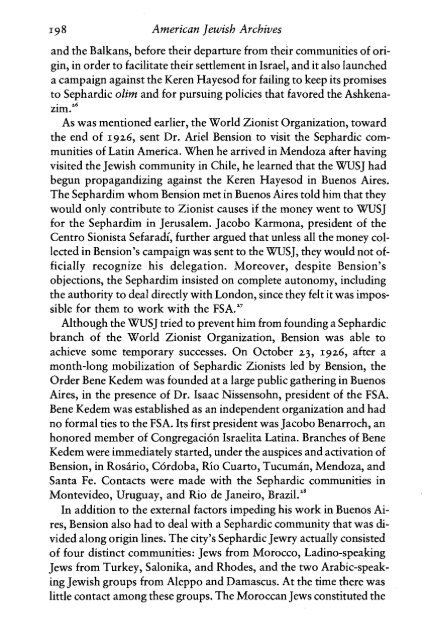Introduction - American Jewish Archives
Introduction - American Jewish Archives
Introduction - American Jewish Archives
You also want an ePaper? Increase the reach of your titles
YUMPU automatically turns print PDFs into web optimized ePapers that Google loves.
198 <strong>American</strong> <strong>Jewish</strong> <strong>Archives</strong><br />
and the Balkans, before their departure from their communities of origin,<br />
in order to facilitate their settlement in Israel, and it also launched<br />
a campaign against the Keren Hayesod for failing to keep its promises<br />
to Sephardic olim and for pursuing policies that favored the Ashkena-<br />
~im.'~<br />
As was mentioned earlier, the World Zionist Organization, toward<br />
the end of 1926, sent Dr. Ariel Bension to visit the Sephardic communities<br />
of Latin America. When he arrived in Mendoza after having<br />
visited the <strong>Jewish</strong> community in Chile, he learned that the WUSJ had<br />
begun propagandizing against the Keren Hayesod in Buenos Aires.<br />
The Sephardim whom Bension met in Buenos Aires told him that they<br />
would only contribute to Zionist causes if the money went to WUSJ<br />
for the Sephardim in Jerusalem. Jacobo Karmona, president of the<br />
Centro Sionista ~efaracli, further argued that unless all the money collected<br />
in Bension's campaign was sent to the WUSJ, they would not officially<br />
recognize his delegation. Moreover, despite Bension's<br />
objections, the Sephardim insisted on complete autonomy, including<br />
the authority to deal directly with London, since they felt it was impossible<br />
for them to work with the FSA."<br />
Although the WUSJ tried to prevent him from founding a Sephardic<br />
branch of the World Zionist Organization, Bension was able to<br />
achieve some temporary successes. On October 23, 1926, after a<br />
month-long mobilization of Sephardic Zionists led by Bension, the<br />
Order Bene Kedem was founded at a large public gathering in Buenos<br />
Aires, in the presence of Dr. Isaac Nissensohn, president of the FSA.<br />
Bene Kedem was established as an independent organization and had<br />
no formal ties to the FSA. Its first president was Jacobo Benarroch, an<br />
honored member of Congregaci6n Israelita Latina. Branches of Bene<br />
Kedem were immediately started, under the auspices and activation of<br />
Bension, in Rosirio, Cordoba, Rio Cuarto, Tucumin, Mendoza, and<br />
Santa Fe. Contacts were made with the Sephardic communities in<br />
Montevideo, Uruguay, and Rio de Janeiro, Brazil."<br />
In addition to the external factors impeding his work in Buenos Aires,<br />
Bension also had to deal with a Sephardic community that was divided<br />
along origin lines. The city's Sephardic Jewry actually consisted<br />
of four distinct communities: Jews from Morocco, Ladino-speaking<br />
Jews from Turkey, Salonika, and Rhodes, and the two Arabic-speaking<br />
<strong>Jewish</strong> groups from Aleppo and Damascus. At the time there was<br />
little contact among these groups. The Moroccan Jews constituted the

















